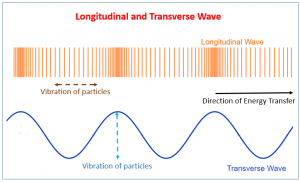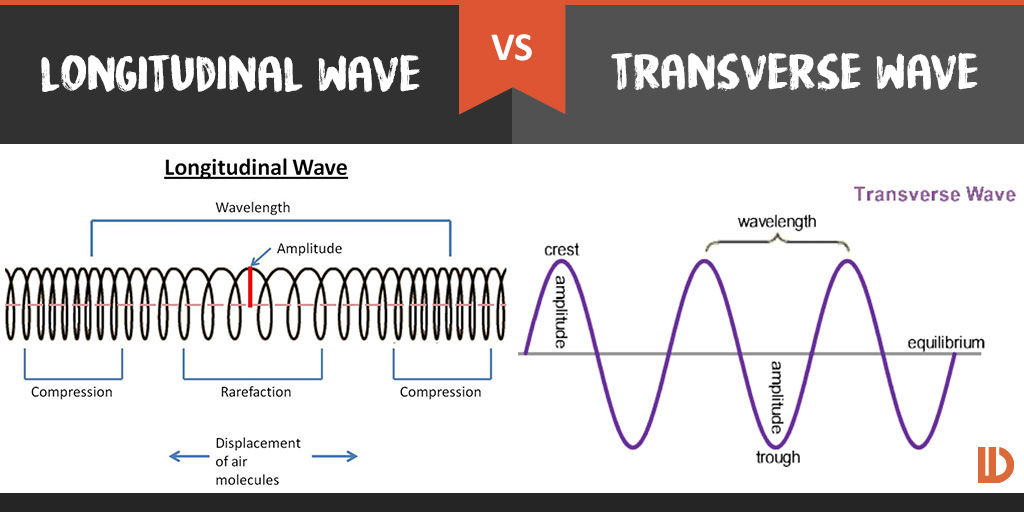Explain How Transverse and Longitudinal Waves Are Different
Transverse Longitudinal Waves Waves Physics FuseSchoolWaves transfer energy from one place to another. Please use 3 content related sentences - 22931644.

Difference Between Longitudinal And Transverse Wave With Its Practical Applications In Real Life
A transverse wave is where the direction of the particles of the medium move perpendicularly to the direction as that of the wave.

. Transverse waves-medium displacement perpendicular to wave motion Longitudinal waves-medium displacement parallel to wave motion. 1 The wave in which the direction of vibration of particle is perpendicular to the direction of propagation of waves is known as longitudinal wave. Define a longitudinal wave.
For longitudinal waves the waves move in parallel direction to the source of vibration. Explain how surface waves can have characteristics of both longitudinal waves and transverse waves. 2 Transverse waves can travel through material medium as well as vacuum.
Generally the transverse waves are made up of crests and troughs. This is the currently selected item. Furthermore the longitudinal wave is one that acts in one dimension.
Transverse waves are waves where the disturbance moves perpendicular to the direction of the wave. A longitudinal wave is one in which the medium particles move in a direction that is parallel to the waves movement. Longitudinal and Transverse Wave Motion.
Longitudinal waves transfer energy parallel to the direction of wave motion and transverse waves transfer energy perpendicular to the direction of wave motion. They are similar in the sense that energy is transferred in the form of waves. Displacement of the medium is perpendicular to the direction of propagation of the wave.
A transverse wave is one in which the mediums particles move in a direction that is perpendicular to the waves movement. Transverse waves When the movement of the particles is at right angles or perpendicular to the motion of the energy then this type of wave is known as Transverse wave. There are two basic types of wave motion for mechanical waves.
You should already know how to describe them i. For transverse waves the waves move in perpendicular direction to the source of vibration. Here the crest is the trough and vice versa.
Longitudinal and transverse waves are mechanical waves so both carry energy through particles of matter. Light is an example of a transverse wave. Water waves are an example of a combination of both longitudinal and transverse motions.
For transverse waves the waves move in perpendicular direction to the source of vibration. For transverse waves the waves move in perpendicular direction to the source of vibration. One difference between longitudinal and transverse wave is with regards to dimension.
Transverse and longitudinal waves are different types of mechanical waves. They are similar in the sense that energy is transferred in the form of waves. The same thing happens for the longitudinal wave when the reflection happens at a rarer medium.
Transverse Waves and Longitudinal Waves Another way to describe a wave is by the direction that its disturbance is traveling. Transverse Waves And Longitudinal Waves In Physics waves are explained as an oscillation about the fixed point which is accompanied by the transfer of energy travelling from one medium to another medium. For longitudinal waves the waves move in parallel direction to the source of vibration.
In contrast the transverse wave is one that acts in two dimensions. Overview of key terms and skills for waves including how to identify longitudinal and transverse waves. Both waves have some common features.
They are similar in the sense that energy is transferred in the form of waves. It is important to understand what are waves to understand different types of waves. Do not be misled sound waves traveling through air are longitudinal waves.
As sound passes through air or any fluid medium the particles of air do not vibrate in a transverse manner. Things to Remember Based on Longitudinal and Transverse Waves. Examples of longitudinal waves include.
You can think of the wave moving left to right while. Example Sound Waves Pressure Waves. A wave can be defined as a dynamic disturbance travelling from one point of medium to another it is further associated with one or more medium properties.
Longitudinal waves and transverse waves. For longitudinal waves the waves move in parallel direction to the source of vibration. A longitudinal wave is where the direction of the particles of the medium move in the same direction as that of the wave.
Do the particles of the medium move along with the wave. Mechanical Waves are waves which propagate through a material medium solid liquid or gas at a wave speed which depends on the elastic and inertial properties of that medium. 6 rows There are various types of waves and two of those would be longitudinal and transverse.
First of all let us check the characteristics of both the waves when reflected from denser and rarer medium. Longitudinal and transverse waves In longitudinal waves the vibrations are parallel to the direction of wave travel. 6 rows If particle vibrates perpendicular to the direction of motion of wave then the wave is known as a.
Examples of electromagnetic waves include light microwaves radio waves and X-rays. Explain one difference between longitudinal and transverse wave. Transverse and longitudinal waves review.
Sound waves traveling through air are indeed longitudinal waves with compressions and rarefactions.

3 02 Explain The Difference Between Longitudinal And Transverse Waves Tutormyself Chemistry

Differences Between Longitudinal And Transverse Waves Explained Youtube

Transverse And Longitudinal Waves

Illustration Of Transverse Versus Longitudinal Wave Source Scalar Download Scientific Diagram

Transverse And Longitudinal Waves Sound Physics And Music Openstax Cnx

Difference Between Longitudinal And Transverse Waves Teachoo

What Is The Difference Between A Longitudinal Wave And A Transverse Wave Socratic

No comments for "Explain How Transverse and Longitudinal Waves Are Different"
Post a Comment